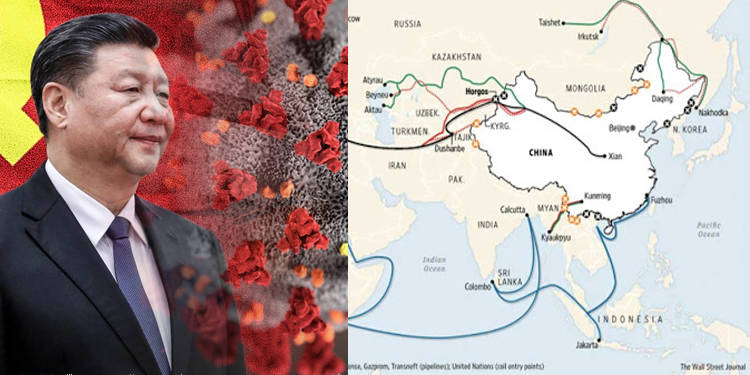As the Wuhan virus Pandemic intensifies across the world, startling revelations about the nexus of Chinese investments across the globe with one of the worst Pandemics of the world have come out.
The China-made Wuhan virus which originated somewhere in the wet markets of the Hubei province of China, has now find its way to geographically distant countries even as the epicentre of the virus shifted to countries like Europe.
Spreading the Chinese virus to other parts of the world is the One Belt One Road (OBOR), wherein China has invested 1 trillion USD in countries across the world. It is not a matter of coincidence that Italy and Iran- both of whom joined the OBOR last year are the second and third worst affected countries in terms of the number of deaths insofar the Pandemic is concerned.
Both Iran and Italy have opened up several sectors of their economy to China, from infrastructure to transportation after signing up for the OBOR- China’s flagship initiative in its larger “debt trap” diplomacy strategy. Consequently, thousands of Chinese workers were employed in the two countries for construction work under the intiative.

Moreover, when bilateral ties are pushed aggressively like in the case of China-Italy/ China-Iran. A number of Chinese officials and citizens, apart from the workers would have travelled to both these countries bringing along the Wuhan virus that has engulfed both the countries severely.
While the sanctions-hit Iran shares warm bilateral ties with China, the latter being the biggest oil importer of Iranian oil, Italy has been trying to ramp up its failing economy and cozied up to Beijing to the extent that there have been rumours about Italy quitting the European Union.
Meanwhile, the prospect of OBOR bringing in the Chinese virus alongwith the Chinese investments is not an unsubstantiated conspiracy theory, but it is a well-corroborated reality of the spread of COVID-19 into these two countries.
In the case of Italy, one of the regions with highest Chinese investments- Lombardy is the worst affected with a mind-boggling number of deaths and one of the first to get infected. Similarly, Tuscany- a region with heavy Chinese investments was also one of the earlier regions to get infected in Italy.
Also, the case of Iran reveals some shocking details. Health workers in the Shi’ite country claim that the China-made Wuhan virus found its way to Qom, one of the holiest cities of Iran which is also the one getting severely affected by COVID-19 pandemic, through either Chinese businessmen or Chinese workers.

Notably, the Railway Engineering Corporation of China is constructing a US $ 2.7 billion high-speed rail line out of Qom. Chinese workers, technicians and businessmen thus routinely travel to this area which has contributed to the abrupt rise in the Wuhan virus epidemic in the Shia-dominated country.
While Iran and Italy clearly seem to be suffering the scourge of joining the OBOR and inviting Chinese investments, there is another case in point, viz. Pakistan- the worst hit country in the South Asian region as far as the Coronavirus Pandemic is concerned. At the time of writing this story, Pakistan had already recorded 501 confirmed cases. This is the official figure and with Pakistan the number can actually be much higher.
In the South Asian region, Pakistan is easily the closest ally of China with massive CPEC investments, a wide array of Chinese projects in the region including in Pakistan occupied Kashmir (Gilgit-Baltistan) and consequently a sizeable number of Chinese travellers. In fact, China is also building an exclusive Chinese colony in Gwadar, Pakistan which will house an anticipated 5,00,000 strong Chinese workforce by 2022. This gives a measure of the air traffic of Chinese citizens to Pakistan.
It is more than probable that like Italy and Iran, the Wuhan virus reached Pakistan too through the One Belt One Road (OBOR) initiative. The heavy Chinese investments in the country, alongwith mass travel from China might have pushed Pakistan into the turmoil that it finds itself in.
The case of Italy and Iran, and also Pakistan exposes the inherent dangers associated with Chinese investments in general and the One Belt One Road (OBOR) intiative in particular. This could shift the global dynamics from here on and add a fresh dimension to the Blue Dot Network (BDN)- “a multi-stakeholder initiative to bring together governments, the private sector and civil society to promote high-quality, trusted standards for global infrastructure development.”
Till now, Chinese investments and especially OBOR had come under the scanner for bringing in exorbitant debts, but in a post-Coronavirus world, it also comes under fire for bringing death and misery manufactured indigenously in China, along with its costly investments. With this BDN might get a push as the risks inherent in Chinese investments become patently manifest.


































